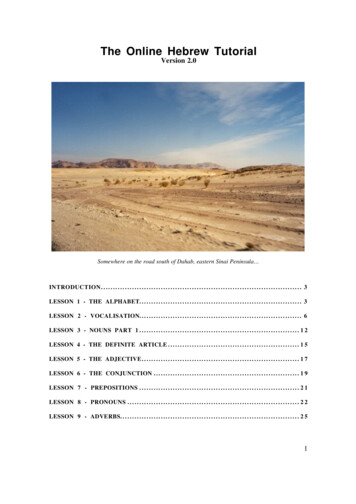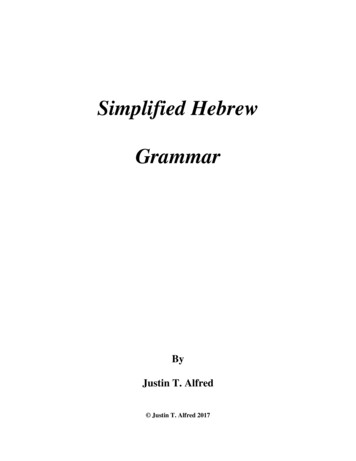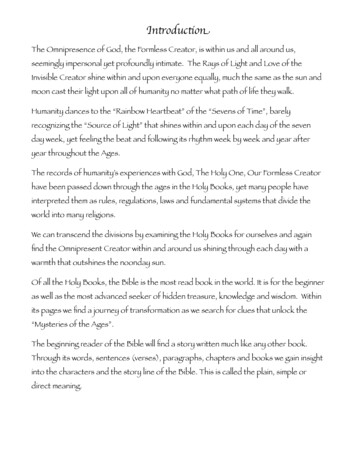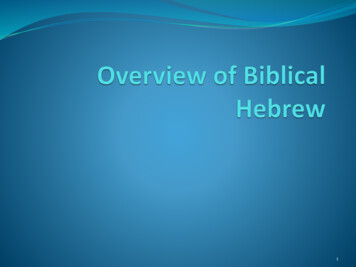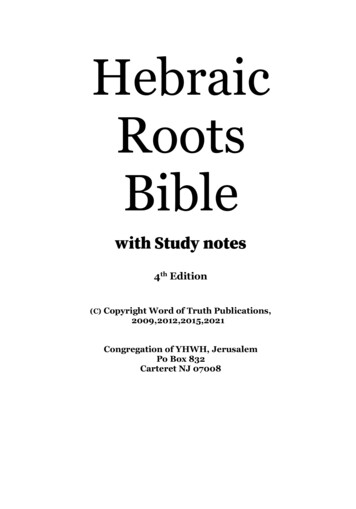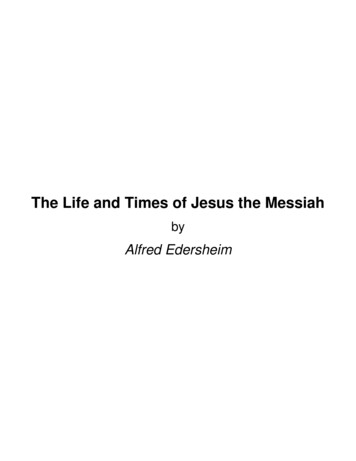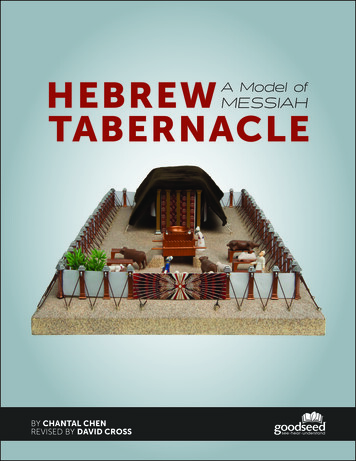
Transcription
HEBREW MESSIAHTABERNACLEA Model ofBY CHANTAL CHENREVISED BY DAVID CROSS
Hebrew Tabernacle: A Model of Messiah11 lessons for group or personal study2nd EditionWritten by: Chantal ChenRevised by: David CrossDesign: Naomi JohnstonePhotography: Troy JohnstoneProofreaders: Janice Cross, Naomi JohnstoneCopyright 2004, 2016 by GoodSeed International.All rights reserved. No portion of this book may be reproduced in any form without the written permission of the copyright holder.GoodSeed, www.goodseed.com and logo design marks are trademarks of GoodSeed International.Published by GoodSeed International, P.O. Box 3704, Olds, Alberta, CanadaEmail: info@goodseed.comScripture quotations marked ESV are from The Holy Bible, English Standard Version, copyright 2001 by Crossway Bibles, adivision of Good News Publishers. Used by permission. All rights reserved.Quotations marked KJV are from the Authorized King James Version.Scripture quotations marked NASB are taken from the New American Standard Bible , Copyright 1960, 1962, 1963, 1968, 1971,1972, 1973, 1975, 1977, 1995 by The Lockman Foundation. Used by permission. (www.Lockman.org)Scripture quoted by permission. Quotations designated NET are from the NET Bible , copyright 1996-2006 by Biblical StudiesPress, L.L.C. www.bible.org. All rights reserved.Scripture quotations marked NIV are taken from the HOLY BIBLE, NEW INTERNATIONAL VERSION . NIV . Copyright 1973,1978, 1984 by International Bible Society. Used by permission of Zondervan. All rights reserved.Scripture quotations marked NIV are from the HOLY BIBLE, NEW INTERNATIONAL VERSION. Copyright 1973, 1978, 1984 byInternational Bible Society. Used by permission of Hodder & Stoughton Publishers, a member of the Hodder Headline Group. Allrights reserved. “NIV” is a registered trademark of International Bible Society. UK trademark number 1448790.Scripture quotations marked NLT are taken from the Holy Bible, New Living Translation, copyright 1996. Used by permission ofTyndale House Publishers, Inc., Wheaton, Illinois 60189. All rights reserved.Scripture quotations marked TLB are taken from The Living Bible copyright 1971 by Tyndale House Foundation. Used bypermission of Tyndale House Publishers Inc., Carol Stream, Illinois 60188. All rights reserved. The Living Bible, TLB, and the TheLiving Bible logo are registered trademarks of Tyndale House Publishers.
contentsPreface ivNotes on Using These Lessons vRecommended Resources viLESSON ONEIntroduction to the Tabernacle 7LESSON TWOThe General Layout 11LESSON THREEThe Bronze Altar 14LESSON FOURThe Basin 18LESSON FIVEThe Lampstand 20LESSON SIXThe Table with the Bread 22LESSON SEVENThe Altar of Incense 24LESSON EIGHTThe Most Holy Place 26LESSON NINEThe Ark of the Covenant 29LESSON TENThe Priesthood, Part One 33LESSON ELEVENThe Priesthood, Part Two 36iii
prefaceJust as Jesus used parables to illustrate and bring to life his teachings, so God frequently used visual aids inthe Old Testament to better illuminate our understanding of many spiritual truths.That is certainly true of the Hebrew Tabernacle—an amazing picture of God’s plan of redemption for mankind.These 11 lessons provide a succinct but meaningful study of the Tabernacle that God instructed Moses toconstruct for the nation of Israel. They go into detail on many of the physical aspects of the Tabernacle andthe spiritual significance of the Tent of Meeting and its pieces of furniture.In the gospels, we read that God—in the person of his Son, Jesus Christ—“became flesh and made his dwelling[literally “tabernacled”] among us” (John 1:14 NIV). These lessons will point out how the Tabernacle is a visualaid that foreshadows and sheds light on the work of Jesus Christ on the cross.May your study of these lessons provide you a deeper glimpse of the awesome and holy character of God.And may you gain a more profound appreciation of the all-sufficient substitute of the Lamb of God—JesusChrist—whom the Lord provided to be the atonement for mankind’s sin-debt.The GoodSeed Editorial Teamiv
notes on using these lessonsA. These lessons are appropriate for personal, group, classroom, homeschool and camp use.B. Because the Scripture references are integral to understanding these lessons, we encourage you tolook up each verse.C. While students can use the illustrations provided to go through the lessons, a Tabernacle modelwill enhance their visualization, appreciation and understanding. Here are two available models.(Purchasing details are at the back.)The Tabernacle Model KitThe Tabernacle Model Kit is a 1:90 scale representationof the Tabernacle constructed by Moses. Consistingof 328 pieces, the completed assembly can be paintedto provide a realistic visual model. Assemblingthe model together as part of the lesson is anideal activity for families and students in schools,homeschools and camps.The Tabernacle Furniture SetThe Tabernacle Furniture Set, at 1:10scale, provides a closer examinationof the key pieces of the Tabernacle.Each furniture piece is made frommetal castings and completed with anelectroplated gold finish.v
recommended resourcesA valuable help to any study of the Tabernacle is understanding its meaning in the broadercontext of Scripture. Providing this larger framework are the following recommended resources.FOR PERSONAL READINGBy This NameThis book helps a person clearly understand what the Bible is all about. Using thearchitecture of the gospel of John, the primary message of the Bible is explained using ahistorical narrative, from creation to the cross. Included in this book is a description of theTabernacle, as well as the significance of this elaborate visual aid in the context of God’sredemptive plan for mankind.FOR LEADING A GROUP STUDYWorldview RethinkWith By This Name as the coursebook, Worldview Rethinkis a robust curriculum for both believers and unbelievers.It has a leader’s guide (with instructions for leading astudy), coursebook, workbook, video clips, a resourceCD and more to lead a study. In the resource CD arefull-colour illustrations of each piece of furniture inthe Tabernacle. Pair the study with the available visualaids for a memorable teaching and learning experience.A Worldview Rethink study is an excellent discipleship resource to help believers (whether they are 3 days or33 years old) layer down on their understanding of faith in Christ. The curriculum provides a solid overviewof all of Scripture, providing the foundation upon which other studies can be built.The study is also ideal for guiding unbelievers through the gospel message because it assumes no priorknowledge about God or the Bible.vi
lesson oneINTRODUCTION TO THE TABERNACLESome may be inclined to dismiss the Old Testament account of the Tabernacle as abewildering relic of a bygone era and irrelevant to our contemporary world. However, thefact that the Bible devotes 50 chapters to the discussion of this tent in the wilderness and itsrelated activities is indicative of the importance God places on this graphic illustration.Read Exodus 24:12–25:9.In this passage, the Israelites had been wandering in the wildernessfor a little less than a year when God summoned Moses up toMount Sinai.Most believers associate Mount Sinai with the giving of theTen Commandments to Moses. However, many are notaware that after returning from his mountain rendezvouswith God, Moses also brought back something elseequally significant: plans for constructing andfurnishing a very special structure, the Tabernacle.Make a sanctuary for me, and I will dwellamong them. Exodus 25:8 NIVThe word sanctuary literally means “holyplace.” The word tabernacle is derived froma word meaning “to settle down, abide.” It isalso referred to in various ways as a “tent”(e.g., Exodus 29:42; Numbers 17:7).Almost a year after God had freed the Israelitesfrom their Egyptian slavery (c. 1450 BC), theTabernacle was first erected. For the next 40HEBREW TABERNACLE7
INTRODUCTION TO THE TABERNACLEyears, it served as a continual reminder of God’s presenceamong his people during their wilderness wanderings(Exodus 40:34-37). Years later, this portable structure wasreplaced by something more permanent—the Temple1 builtby King Solomon.Though much larger and much more magnificent,this Temple retained the similar design of the originalTabernacle. Then, in 586 BC, Solomon’s work wasdestroyed by the invading forces of the BabylonianEmpire. Subsequently, a much simpler structure wasconstructed on the same site. Centuries later, this SecondTemple was greatly expanded by King Herod—creatingan awe-inspiring edifice that rivaled that of Solomon’s.This was the Temple Jesus was familiar with.Discussion 1: A Unique Dwelling Place1. The Lord did not ask the Israelites to constructthe Tabernacle because he needed a house.Q: Why doesn’t God need a house to live in?A: Scripture is very clear that God is not confined to a particular building or place.The God who made the world and everything in it, who is Lord of heaven and earth, does not livein temples made by human hands. Acts 17:24 NETGod’s greatness and immensity cannot be confined within any shrine or structure. Any other suggestionwould prompt a rhetorical question from God:“The heavens are my throne and the earth my footstool. Where then is the house you will build forme? Where is the place where I will rest? My hand made them; that is how they came to be,” saysthe Lord. Isaiah 66:1-2 NETAny other concept of God is too small.2. Nevertheless, it has always been God’s desire to make the reality of his presence known among hispeople. In 1 Chronicles 6:48 (NIV), the Tabernacle is referred to as the “house of God.”Q: Keeping in mind the previous discussion, what would have been significant about the Israelites thinkingof the Tabernacle (and later, the Temple) as the house of God?A: Nowhere in Scripture is there any indication that the Israelites thought of the house of God in anyway other than in figurative terms. Rather, its usage was a reminder of the unique privilege they aloneenjoyed—out of all of the nations of the world—of having the presence of God in their midst.Q: How has God demonstrated his presence among his people throughout history—past, present, future?A: Jacob was made particularly conscious of the presence of God through a dream. Afterward, he set upa stone as a memorial marker, naming the place Bethel—the house of God (Genesis 28:10-19).As God’s earthly “dwelling place,” the Tabernacle was never meant to be a permanent structure. Almost500 years later, it was replaced by the Temple built by King Solomon (1 Kings 6:1).HEBREW TABERNACLE8
INTRODUCTION TO THE TABERNACLEIn the gospels, we read that God—in the person of his Son, Jesus Christ:.became flesh and made his dwelling [literally “tabernacled”] among us. John 1:14 NIVSince then, much more than living among his people, God now “indwells” his people—those who haveput their trust in Christ—by the Holy Spirit.Don’t you realize that your body is the temple of the Holy Spirit, who lives in you and was given toyou by God? You do not belong to yourself. 1 Corinthians 6:19 NLT; cf. 1 Corinthians 3:16-17Ultimately, believers will enjoy the presence of God dwelling in their midst for eternity (Revelation 21:3).3. The Tabernacle was also referred to as the Tent of Meeting. However, unlike a church, it wasn’t meantto be a place of collective worship.Q: If the Tabernacle was not the Old Testament equivalent of today’s churches, what did the name Tent ofMeeting signify?A: It signified that this was where God took the initiative to meet with his people and communicate withthem (Exodus 29:42-43).4. Centuries later, during the time of King David, Israelite worship took on more of the characteristicsof what we understand the word to mean today, with the Tabernacle or Temple as its focal point. Yet,regardless of how their worship was expressed, it wasn’t the physical structure of the Tabernacle orthe activities associated with it that were the essential requirements for genuine worship.Q: If the Tabernacle wasn’t the key component of true worship, what was? What is?A: From the very beginning of time, at the heart of worship is a right relationship with God. Worship ismeant to be the natural overflow of an understanding of who God is and what he has done for man, resultingin a response of faith. When worship is divorced from a simple trust in God’s provision (as pictured by theactivities that went on in the Tabernacle and its related activities), any pretense of worship is simply emptyand meaningless. (For God’s thoughts on such religious practices, see Isaiah 29:13; Amos 5:21-23.)Discussion 2: God’s idea, God’s initiative, God’s design1. We noted earlier that when Moses came down from Mount Sinai, he not only brought the stone tabletsinscribed with the Ten Commandments, but also plans for constructing and furnishing the Tabernacle.Q: What was God’s purpose for each of these two sets of instructions?A: The Ten Commandments were meant to make man aware in a new way of the standard of righteousnessto which God holds everyone accountable—a standard that is a reflection of God’s innate holiness.Everyone has sinned; we all fall short of God’s glorious standard. Romans 3:23 NLTAt the same time, however, God also provided a very visual depiction through the Tabernacle of howmankind could come back into a right relationship with himself in spite of man’s persistent failings.2. Because the Tabernacle was so significant, God took care to give explicit instructions as to how hewanted it constructed. God spelled out every detail.Make this tabernacle and its furnishings exactly like the pattern I will show you. HEBREW TABERNACLE9Exodus 25:9 NIV
INTRODUCTION TO THE TABERNACLEQ: Why was God so insistent that the Tabernacle be built a certain way?A: [The priests] serve in a system of worship that is only a copy, a shadow of the real one in heaven. Forwhen Moses was getting ready to build the Tabernacle, God gave him this warning: “Be sure that youmake everything according to the pattern I have shown you here on the mountain.” Hebrews 8:5 NLT; cf. Hebrews 10:1Built according to a precise pattern, the Tabernacle was just a model or representation of God’s relationshipwith man. The model pointed ahead to something better.Furthermore, God wanted nothing that might possibly misrepresent his picture of how sinful man couldapproach a holy God and find forgiveness. So, God required that the Tabernacle be built exactly accordingto his specifications.God even selected who was going to do the construction (Exodus 35:30-35). He didn’t want any shoddywork. He wanted everything done right.What may appear to us to be excessively demanding wasn’t intended to burden the people, but ratherto show God’s unquestionable authority and holiness, and to emphasize that people could only come toGod on God’s terms, not their own.3. Just as Jesus used parables to illustrate and bring to life his teachings, so God frequently used visualaids in the Old Testament to better illuminate our understanding of many spiritual truths taught inthe New Testament. That is certainly true of the Tabernacle—an amazing picture of God’s plan ofredemption for mankind.Q: Why is it so important that we understand God’s plan of redemption (or God’s rescue plan)?A: From the beginning of time, God’s desire has been to have a relationship with mankind. The TenCommandments made sinful man conscious of how far short he fell of God’s awesome holiness. Now, Godgave Moses instructions that were intended to provide a graphic illustration of how man’s relationshipwith his Creator—broken and ruined by sin—could be restored. These building plans highlighted thefact that this restoration was only possible on God’s terms, according to his righteous standards. As such,there was both present and future aspects—both symbolic elements and their future fulfillment—inherentin what the Tabernacle was all about.As our study continues, we will be taking a closer look at the Tabernacle and its furnishings. However, wewon’t be examining every possible detail. There is much that is beyond the scope of this study. Rather,we will be focusing our attention on the primary lessons that we can draw from what the Scriptureclearly presents. Because much of it is symbolic, our aim is to allow the Bible to speak for itself andallow “Scripture to interpret Scripture.”Endnote1. For the purpose of these lessons, the significance of the terms Tabernacle and Temple will be considered to be identical.HEBREW TABERNACLE 10
lesson twoTHE GENERAL LAYOUTRead Exodus 26:1-30; 27:9-19.To summarize this long passage, the Tabernacle consisted of a tent-like structure and an external courtyard.Everything, including its furnishings, was easily portable. The prefabricated design of the entire Tabernaclemeant that it could be easily dismantled and erected.The tent—the Tabernacle proper—was divided into two areas, the Holy Place and the Most Holy Place. Thestructure was 13.8 metres (45 ft)1 long and 4.6 metres (15 ft) wide. Acacia boards, overlaid with gold, werefitted together vertically to form the walls. Overlaying the tent-like structure were four layers of coveringsthat acted as a roof, shielding the Tabernacle furnishings from the sun and rain.The whole compound—46 metres (150 ft) by 23 metres (75 ft)—was surrounded by a high fence made offabric. On the east side, a single gate provided access to the enclosure.Discussion 1: The Fence1. The symbolic presence of God dwelling with his people was at the very centre of the Israeliteencampment, yet the Tabernacle could not be freely entered as anyone chose. A 2 metre (6.5 ft) highcurtain, supported by a series of bronze posts, completely surrounded the courtyard.Q: In what way did this curtain function as a security fence?A: The fence acted as an insurmountable wall. Not only did it mark a physical separation but it alsorepresented the spiritual gulf that separates sinful man from a holy God. The perfect righteousness ofGod far exceeds even the best efforts or possible merit of any person to bridge that chasm (Romans 3:23).Q: In what way did the curtain serve as a protective barrier?A: As a protective barricade, the fence excluded from the presence of God all that was sinful and impure.2. The Tabernacle enclosure—encircled by a white linen curtain—would have stood out in contrast tothe rest of the Israelite encampment.HEBREW TABERNACLE11
THE GENERAL LAYOUTQ: What is the significance of white in contrast to everything else?A: We often associate the colour white with the idea of purity. The Bible tells us that purity—orrighteousness—is one of the inherent characteristics of God that sets him apart as totally distinct fromall of his creation.Your eyes are too pure to look on evil; you cannot tolerate wrong. Habakkuk 1:13 NIVThe white fence marked a distinct line of demarcation between what was acceptable and pleasing to Godand what was not. There was no “grey” area.Discussion 2: The Gate1. God had commanded that the fence be built, but he also specifically provided for an entrance—a singlegate, 9.2 metres (30 ft) in width. This gate also consisted of a linen curtain. Beautifully embroidered,its distinctive nature clearly distinguished the entryway in contrast with the curtain that surroundedthe rest of the outer court.Q: Of what should this remind us?A: The God of righteousness is also a God of mercy and grace who has made a way whereby mankindcan come into his presence.2. Access to the Tabernacle was restricted by a fence.Q: What would be the significance of this to the people in Moses’ time?A: A person could not enter from any direction he pleased—he had to enter through one gate. Therewere no alternatives—no rear or side entrances. He could only come through the one provided gate,illustrating that for man to approach God, he had to come in God’s prescribed way. There was noother way.The fact that there was only one entryway also meant that the way to God was the same for everyone.No one received preferential treatment based on their place of birth, educational opportunities orstatus in society.Its width was suggestive of God’s open invitation to all to come.And it was easily accessible—there was nothing complicated.3. The Tabernacle was always erected with the entrance positioned on the east side.Q: What was the significance of this? (Hint: From which direction does the sun rise?)A: Because of the position of the gate, the Israelites were always facing west as they entered thecompound, in contrast to the practice of the pagan sun-worshippers of the day who faced theopposite direction—toward the east. (See Ezekiel 8:16-18 for an example of this form of idolatry, thistime practiced by Israelites themselves.2)4. The following are two of Jesus’ famous “I am” statements:I am the way and the truth and the life. No one comes to the Father except through me. John 14:6 NIVI am the gate; whoever enters through me will be saved. HEBREW TABERNACLE 12John 10:9 NIV
THE GENERAL LAYOUTQ: How did the Tabernacle gate point to Jesus Christ?A: The gate is a representation of Christ as the one and only way through which a person can enter intoa right relationship with God. There is no other way. Jesus made that possible when he paid our sin-debton the cross in our place. To approach God, a person must enter in through the only gate—putting hisfaith in Christ alone.The Tent-like StructureLocated within the fence that encircled the compound was theTabernacle proper. To the casual onlooker, this tent-like structuremust have seemed rather ordinary. There was nothing particularlydistinctive about it, apart from the column of cloud that hoveredover it by day. However inside, as we shall learn, was quite anothermatter for it was here that man communed with God in the HolyPlace and where God symbolically dwelt among his people in theMost Holy Place.The Tabernacle FurnitureThe Israelites were given detailed directions for the making ofseven unique pieces of furniture to be placed both within thecourtyard and the Tabernacle proper. As visual aids, they mayseem very simple, but for the Israelites who didn’t have the benefitof the Holy Spirit to teach them, each element of the Tabernaclewas a powerful illustration of a spiritual truth. (This would alsobe true of all the visual aids and word pictures found throughoutthe Old Testament.)While God provided the plans for the Tabernacle’s construction,it was the Israelites who were responsible for providing theresources necessary for the building project itself, including allits furnishings. The gold, silver and linen probably came from theEgyptians months earlier when God delivered his people frombondage (Exodus 12:35-36). After almost 400 years of slavery, someform of back wages seems very appropriate!As our study continues, we will consider what the significance of themajor components of the Tabernacle meant to the Israelites of thatday, and we shall also look at the lessons God wants us to learn today.Endnotes1. The Hebrew unit of measurement, known as a cubit, referred to both a “common” (44.5 cm/17.5 in) and a “long” (51.8 cm/20.4 in)length of measurement. Most scholars believe that the unit used in Scripture (as used throughout these lessons) was the commoncubit. (Henry M. Morris, The Genesis Record (Grand Rapids, Michigan: Baker Books, 2009), 181.2. This is an example of syncretism, a mixing of truth and error—in this instance, worshipping an idol in the very place meant to bedevoted alone to the worship of the one true, living God.HEBREW TABERNACLE 13
lesson threeTHE BRONZE ALTARRead Exodus 27:1-8.Immediately inside the entrance to the Tabernacle courtyard was the first of seven unique pieces of furniture—alarge bronze altar. It was meant to serve as the one central site for offering sacrifices.Made of acacia wood and overlaid with bronze, the design meant that it was fire-resistant, yet light enoughto be carried. Also referred to in Scripture as the “altar of burnt offering,” this altar measured 2.3 metres by2.3 metres (7.5 ft x 7.5 ft) and was 1.4 metres (4.5 ft) in height. It replaced the use of previous altars that hadbeen periodically constructed by previous generations of Israelites (e.g., Genesis 8:20). These earlier altarshad been made of heaped stones or of earth (Exodus 20:24-25).From the very beginning of time, altars were central to Scripture. Though we always find God’s peoplebuilding altars, yet there were—and are to this day—plenty of counterfeits found throughout the world.Many religions attempt to appease or otherwise manipulate their gods through the use of altars. In firstcentury Greece, Paul.even found an altar with this inscription: TO AN UNKNOWN GOD. Acts 17:23 NIVDiscussion:1. The bronze altar was an important component of what God designed to be the focal point of Israelitelife. Among the various offerings mandated by God, the primary ones were animal sacrifices.The life of a creature is in the blood, and I have given it to you to make atonement for yourselveson the altar; it is the blood that makes atonement for one’s life. Leviticus 17:11 NIVQ: Most of us find the shedding of blood to be repulsive and abhorrent. Though the Bible doesn’t specifically say, whatpossible explanation might there be for this being an essential part of God’s plan in resolving man’s sin problem?A: In some measure, this requirement ought to be a reminder of the enormity of our sin in God’s sight.If we react in horror to the thought of blood being shed or taking an animal’s life, it should give us somesense of how God views our sin if his solution requires such an action.HEBREW TABERNACLE 14
THE BRONZE ALTARYou [God] are pure and cannot stand the sight of evil. Habakkuk 1:13 NLTQ: Why did God require these sacrifices be made if, as the Bible also states, “it is impossible for the blood of bullsand goats [i.e., animal sacrifices] to take away sins” (Hebrews 10:4 ESV)? What was their purpose?A: God’s plan and purpose from the very beginning was that these offerings were meant to serve as pointersto a future time when God himself would provide a perfect, once-for-all provision for man’s sin problem.Tragically, many Israelites made the same mistake as people often do today. They focused on the outwardform and failed to recognize that the ritual was a visual aid, a reminder of what God was planning todo for man. Without this understanding, the sacrifices were empty and meaningless, thus the reason forthe reminder of the verse in Hebrews 10:4.2. As we were reminded in our first lesson, God gave to Moses on Mount Sinai the Ten Commandments,also referred to as the Law.Q: What were these commands meant to signify in the minds of those bringing sacrifices to the Tabernacle?A: The purpose of the Law was to make man aware of what God views as sin. In the Bible, Paul writes:I would not have known what sin was except through the law.The apostle then goes on to give an example:I would not have known what coveting really was if the law had not said, “Do not covet.” Romans 7:7 NIVElsewhere, Paul adds that God designed the Law so that:.sin might be recognized as sin so that through the commandment sin might become utterly sinful.Romans 7:13 NIVIt was through the Law that man became conscious—convicted—of the sinfulness of sin. Before God’sholy standard of right and wrong, all of mankind stood guilty.Now we know that whatever the law says, it says so that every mouth may be silenced and thewhole world may be held accountable to God. Romans 3:19 NET3. Strategically located, the bronze altar was the first thing one encountered upon entering theTabernacle complex.Q: What did the position of the altar in the Tabernacle courtyard signify to Israelites bringing their offerings?A: For those conscious of the meaning of the Ten Commandments, they would have been deeply awarethat they were guilty, helpless sinners in need of forgiveness. In coming to the altar, they would havebeen reminded that the first step to a right relationship with a holy God was through a blood sacrif
study), coursebook, workbook, video clips, a resource CD and more to lead a study. In the resource CD are full-colour illustrations of each piece of furniture in the Tabernacle. Pair the study with the available visu


